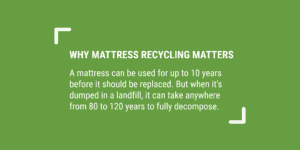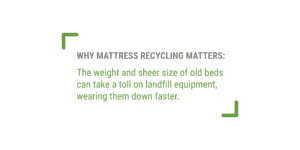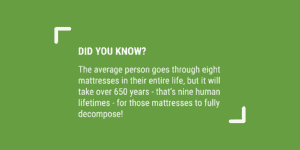Canadians landfill about six million mattresses each year across the country. Some provinces support mattress recycling programs. But not all of them do. And even within the provinces that have mattress recycling programs, services can be limited by regions and cities.
In British Columbia, Alberta, and Manitoba, private recyclers have set up shop to take residents’ mattresses off their hands. In Metro Vancouver, Canadian Mattress Recycling services over 10 municipalities, and their facility is open seven days a week to process items for recycling.
The truth is, most mattresses are still being dumped at landfills. Landfills are in charge of their own recycling programs, often diverting recyclable mattresses to private facilities for dismantling.
How Mattress Recycling Works
In the provinces (and cities) with mattress recycling programs, recyclers dismantle old beds and box springs. They take apart the beds layer by layer, sorting the materials for processing. Often, they work with foam, polyester, metal, and wood. The result from their efforts leads to a success rate of 95% to 100% of materials they recycle – these businesses can recycle up to 100% of the bed you sleep in!
But you may be wondering, why is mattress recycling important?
Reason #1. Mattresses take up space in landfills.
Landfills find disposing mattresses and old beds a challenge. Compared to other garbage, mattresses occupy 400% more space. Sometimes, too many mattresses dumped in landfills can cause overcapacity issues. Landfills then have to reject items or increase their space. However, it’s difficult for a landfill to expand these days due to environmental regulations. Therefore, landfills deal with mattresses by seeking out other businesses that can take them.
For example, in Metro Vancouver, Canadian Mattress Recycling provides recycling services for several municipalities. Landfills receive mattresses from residents and separate clean ones from dirty. Then, they ship the clean ones to our facility for recycling.
Reason #2. Mattresses can wear down landfill equipment.
If you’ve ever tried lifting a mattress, you’ll find they’re usually pretty heavy. This weight poses a problem for landfill sites because the sheer weight and size can wear down equipment faster. Repairing these equipment can be costly for landfills, especially since they have other items to process. In comparison, recycling facilities that take mattresses are often equipped with specific tools to make mattress recycling easier and effective. Specialized equipment, tools, and processes all make mattress recycling possible.
Reason #3. Mattresses take decades to decompose in a landfill.
A mattress kept in good condition lasts for a decade, sometimes even longer. So what does this mean when you dump one in a landfill? Mattresses dumped in landfills can take anywhere from 80 to 120 years before the mattress is fully decomposed. Now, consider how many mattresses a person uses in their entire lifetime, and you can start to picture why we need mattress recycling.
Reason #4. Decomposing mattresses release toxic chemicals in landfills.
Mattresses decomposing in landfills slowly release toxic chemicals. Manufactures treat some portions of mattresses with chemicals when they’re made. Foam and fabric can also contain chemical elements. When these materials decompose, they react to natural elements such as wind and rain. Exposed metal springs from bed frames can corrode. A toxic sludge builds up in the landfill’s soil. Then the next time it rains, this sludge seeps into the ground and runs off the site. Eventually, the chemicals from your bed end up in water systems, polluting the environment.
Reason #5. Recycling a mattress recovers valuable materials.
One reason that recycling is popular is because it recovers valuable materials for reuse. People may think recycled materials are flimsy, but that’s not always the case. When we talk about mattresses, think about the materials used to make them. Manufacturers often build mattresses out of expensive and high-quality materials so they last as long as they do. Therefore, it’s a shame to throw all that material away! A mattress recycler can often divert 95% to 100% of a mattress’s material. Coir, foam, metal, and fabric can be sent to secondary markets to be made into new products.
Conclusion
Mattresses can be difficult to recycle – but there are recyclers across Canada that are taking up the cause of reducing the number of mattresses that end up in landfills. If you’ve ever wondered why people even bother to recycle a mattress, simply consider how long it will take a mattress to decompose. Often, you’re looking at 80 to 120 years. Landfilling a mattress impacts everyone – from landfill sites to their operators, to residents and natural habitats. So if you can, recycle your mattress. It’s the right thing to do.









